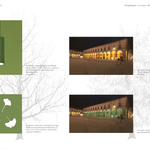Foglie al vento
The last project of this overview is Foglie al vento, presented at the competition Arte per piazza Matteotti in Imola (Bologna) in 2010 for the realisation of a new memorial for the fallen in the Great War to be placed in the restored Renaissance square.
The project, that did not win the competition, consists in the creation of a light installation that should be considered definitively anti-monumental from a formal point of view, in the portico alongside one of the four sides of the square. At the center of each one of the fourteen vaults of Palazzo Sersanti’s portico Vitone imagines a luminaire, which through a specifically designed optical system would projects on the ground the image of fourteen green leaves of a plant chosen for its strong symbolic value.
In the documents submitted to the contest Vitone explains the meanings of the installation, dedicated, according to his words, “to war victims, commemorating not only the dead, but also the wounded and the survivors who have lived and suffered through these horrors”. Vitone chooses the Ginko’s leaves, a sacred tree for the oriental culture, which survived the nuclear tragedy and comes from China, one of the cradles of humanity and an archetypical place for a memory of our civilization that the artist would thus have evoked and remembered, as an homage to all the war victims.
It is then an anti-monumental methodology this one, that we could trace in an impalpable lighting design as well as in the material used to build a monument made only of a perfume, the one of the rhubarb that recalled the Eternit in Per l’eternità. This work, followed and accompanied by a video with the same title, and presented at the Italian Pavillion of the Venice Biennale in 2013, was in fact an invisible monument to the victims of a silent war that has killed so many people, particularly on the site of the Eternit factory, Casale Monferrato.



